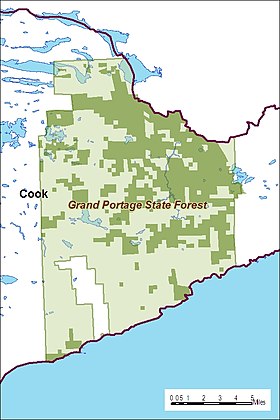| Grand Portage State Forest | |
|---|---|
| Geography | |
| Location | Cook County, Minnesota, United States |
| Coordinates | 47°56′07″N89°56′35″W / 47.9351665°N 89.9431483°W |
| Elevation | 1,378 feet (420 m) |
| Area | 99,200 acres (40,100 ha) |
| Administration | |
| Established | 1933 |
| Governing body | Minnesota DNR, USFS, private |
| Website | www |
| Ecology | |
| WWF Classification | Western Great Lakes Forests |
| EPA Classification | Northern Lakes and Forests |
| Disturbance | Wildfire |

The Grand Portage State Forest is a state forest located near the community of Hovland in Cook County, in extreme northeastern Minnesota, United States. The forest encloses Judge C. R. Magney State Park, Swamp River Wildlife Management Area, Hovland Woods Scientific and Natural Area, and Spring Beauty Hardwoods Scientific and Natural Area. It borders the Grand Portage Indian Reservation to the east, the Superior National Forest to the west, and Ontario to the north. The forest is named after the Grand Portage, a historic trade route between the Great Lakes and the Northwest.
